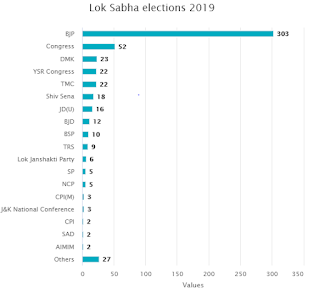And here we go
again, Mr.Modi is back, this time more stronger. Whilst the liberal elite have
been liberally scattering words like ‘populists’, nationalists’ and ‘hindu
extremists’ like jelly beans every time they invoke Modi’s name, which
incidentally is all the time, the Indian populace had other ideas. Completely
oblivious to this elite chatter they enthroned Modi, this time coronation Modi
2.0 is embellished with a 7% increase in the vote share compared to 2014, a 45%
overall vote share that is unprecedented since the Nehruvian era and Modi’s
incursion as a powerful force in the South and West Bengal, to name a few.
The 'Mahagatbandhan', the grand alliance comprising of Congress, the left and a conglomerate of regional parties are understandably
aghast and frantically searching for the reasons behind their abject rejection. Rather than soul searching, after a peripheral scrutiny of their ignominy and humiliation, Modi’s victory is attributed to change in India’s mind-set. “The left has
gone right in Bengal” claimed an NDTV reporter, “people are veering towards
extremism”, proclaimed another on the social media, such a victory couldn’t
have been possible without tampering the electronic voting machines, decreed
another bright spark. “The only plausible explanation starts with the
construction of the most extraordinary personality cult in modern Indian history”,
writes the great Shashi Tharoor.
On the other hand,
the bhakts(unapologetic followers of Modi) are explicably euphoric, attributing this phenomenal success to
their infallible dear leader . Whatsapp groups and Twitterati are replete with hackneyed
citations of enormous strides India has made under Modi’s premiership, conveniently
ignoring the fact that Indian economy is in far worse state than in 2014 and
India ranks a paltry 130 in the human development index (HDI) of the 184
nations for which HDI is calculated. To put into perspective India is
sandwiched between Tajikistan and Cambodia in the HDI rankings but these are
impervious to bhakts’ vision (or lack of it) of India’s place in the global
world.
In this polarised
world of parochial ideologies on either side of left-right spectrum, where
one’s commitment to their half-baked opinions are unduly amplified by
social-media, a nuanced centrist view on any discourse is gasping for breath in
the hate filled echo-chambers. The binary ‘black or white’ thinking and a blinkered perspective leaves no place of middle ground, you are either a patriot or
a traitor, either for open borders or a vile xenophobe, a staunch feminist or a
chauvinistic bigot. How do you explain Modi 2.0 amidst this fundamentally
flawed backdrop? Has India gone mad with Hindutva as ‘The Atlantic’ has fervently
claimed? Or, is there a simpler explanation that conforms to the principle of
parsimony (also called the Occam’s razor), a very important heuristic that is
often ignored in seeking plausible explanations amidst competing hypothesis.
For those who have
been never introduced to the William Okham(c 1287 -1347), Okham(Occam)
postulated that simpler explanations are more likely to be correct than the
complex ones. Let us assume an industrious student who scored poorly in an
examination. One simpler explanation could be that the student, albeit
diligent, did not prepare to the best of his or her ability. Or, the paper was
extremely challenging. May be, this subject was not his or her strongest
subject. These explanations can mostly account for the student’s bad performance,
but it could also be additionally hypothesized that the student was in an inebriated
condition during the exam. May be, the student did very well but due to an
administrative mistake, half of his(or hers) answer papers were somehow blown
away during transit. Or, the person marking the paper has a real contempt for
students and was hell bent on failing every other student, moreover his wife had left him
recently. These latter explanations are much more complex and calls for
unwarranted assumptions while the former assumptions give us a more or less a
cohesive reason for poor results.
Could Modi’s
victory be explained without resorting to far-fetched interpretations such as
that a billion people had pandered to right-wing Hindutva ideology? Or that the
elections were rigged and that the electronic voting machines (EVM) were
possessed or tampered with? Or perhaps, Occam’s razor would suggest a simpler
explanation, an utter ineptitude of the opposition that fought the election on
a single agenda, to depose Modi. What complemented Modi’s ascendancy to second term was the gaping
vacuum of alternative leadership, an opposition bereft of any viable ideas with
an intoxicating addiction to Gandhi-Nehru dynasty and an alliance of other
regional parties that infantilized the public with their trite slogans instead
of robust policies. As the old saying goes, donkeys led by a lion are more
effective than lions led by a donkey. Could it be that opposition was a group
of donkeys led by a donkey?
Let us rewind the clock
back to 2004, BJP were in power for a full term under the late Atal Bihari
Vajpayee’s premiership. One of the most respected politicians of the
post-congress era, a soft-spoken moderate and an astute administrator, Vajpayee
advanced the economic reforms of the previous Government and successfully
fought the Kargil war with Pakistan. During his reign, India successfully
conducted the nuclear tests (Pokhran II) and was recognized as a global nuclear
power despite some initial pushback from United States. There is no doubt that
BJP was instrumental in whipping up the Hindu sentiments in the early nineties,
but Vajpayee was highly respected domestically and had won the accolades of
many foreign leaders during his reign. “India shining” was the motto of BJP’s 2004
manifesto and having won a war with Pakistan, one would have assumed a
comfortable return to power for Vajpayee. Against all odds, people of India
chose UPA(Congress Alliance) led by Sonia Gandhi in 2004 and again in 2009 as
if the billion people somehow had a collective amnesia of their Hindutva identities
for 10 years.
A decade of UPA’s government
is only remembered for litany of scams and scandals such as the reprehensible Commonwealth
games scam, brazen 2G spectrum allocation scandal and the Coalgate scam, which had
left a bitter taste despite a very capable prime minister in Dr. Manmohan
Singh, the prime architect of economic reforms in the mid-nineties. The sheer desperation
to displace this dreadful government was too strong and compelled the electorate
to look for alternatives. Under this backdrop of rampant corruption and crony
capitalism, arose Modi 1.0, a tea-seller-turned-chief-minister of state of
Gujarat, with a perceived track record of shrewd administration and economic
growth. Modi conjured up a presidential-style election campaign in a
parliamentary democratic system and was able to unite the nation promising
corruption-free administration.
In 2019, Modi has
successfully re-enacted his presidential-style campaign. But is there any truth
in the claim that part of Modi’s victory has right-wing hindutva underpinnings?
Make no mistake, Modi and his cohorts are blatantly Hindutva apologizers inspired
by regressive RSS ideology that energized a sizeable minority of unhinged
bhakts peddling anti-Muslim/Christian claptrap with glee. In a nation of a
billion people, that sizeable minority would run into millions of bigoted
individuals poisoning the public discourse. Any attempt to criticize Modi or
his botched implementation of demonetization would be countered with a barrage of
vitriolic comments littered with ’anti-indian’, ‘sickular’, ‘presstitue’ and
other ridiculous drivel from these jingoistic Modi supporters but this alone
cannot explain the Modi wave.
Another principle
that is often ignored is that two things can be true at the same time. One cannot
ignore the right-wing leanings of Modi-Amit duo, a cavalier attitude in
stubbing out cow vigilantism and an alarming rise of anti-secular values, but it
is equally true that in the absence of half-decent opposition, India chose Modi
not because of hindutva but despite hindutva and as a trade-off for a long-term
stable government, an exercise in ‘better the devil you know than the devil you
don’t’, plain and simple.
Modi’s first term
has not been stellar by any stretch of imagination, India’s growth in the
last five years has been lackadaisical. To borrow Shashi Tharoor’s phrase, Modi
has been a paradoxical prime minister who over promised and under achieved
despite some well-intentioned popular schemes. Under Modi’s premiership, constitutional
and statutory institutions have been undermined with undue political interference,
something that has been a feature of every government before Modi. Child poverty
and malnutrition is rife, Indian educational system is crippled, youth unemployment
is high and access to quality health for vast majority of population is still virtually
inaccessible. Yes, it is unfair to
expect Modi to have made a major impact in 5 years given several decades of inexcusable
neglect by previous governments, but it’s hard to see what structural changes
that his government has implanted in the first term that can be reaped in the
next five years.
Unless, the opposition steps up to find a visionary leader who
can match Modi’s style and exuberance with an alternative message of unity and prosperity not based on caste and religion lines, India will continue to chose the lesser
of the evils and Indian electorate will be expediently branded populists and
nationalists for doing so.




